The Cambridge History of Japan, Vol. 4: Early Modern Japan
Подождите немного. Документ загружается.

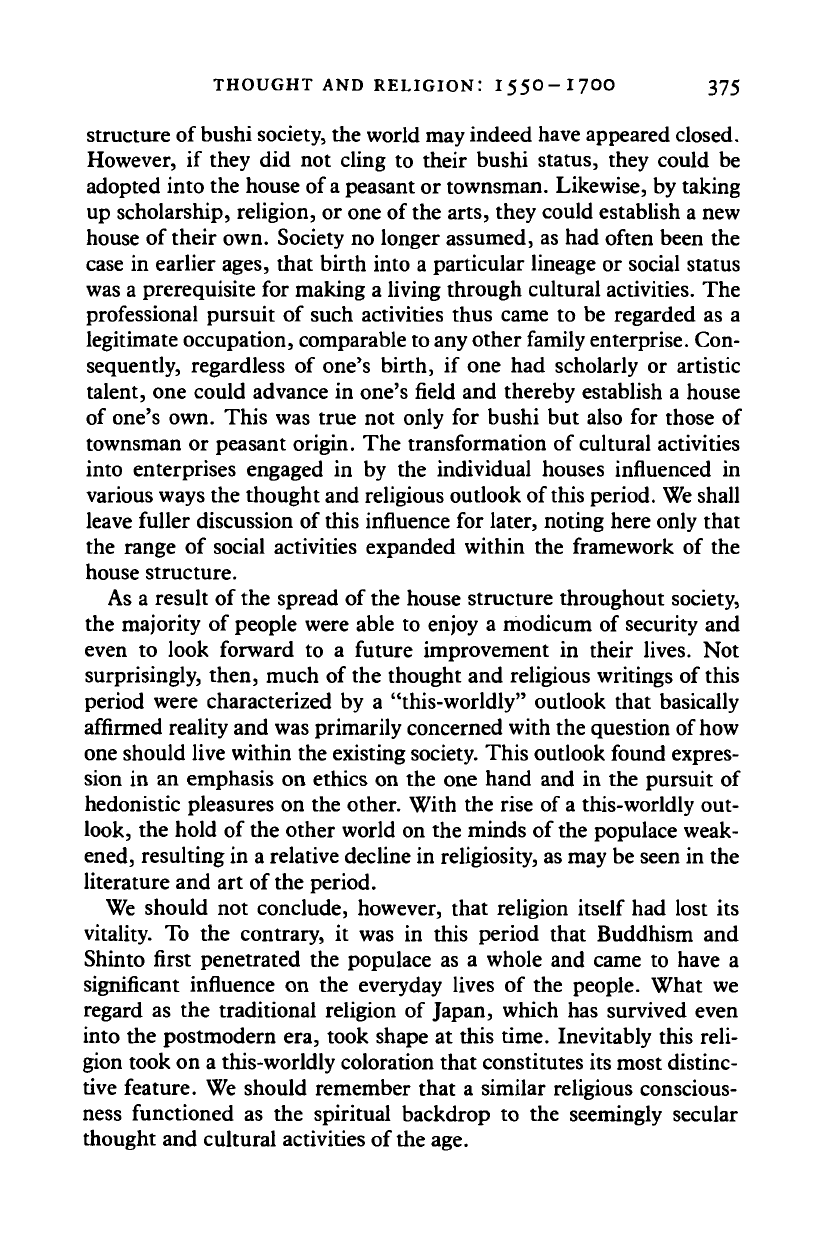
THOUGHT AND RELIGION: I55O-I7OO 375
structure of bushi society, the world may indeed have appeared closed.
However, if they did not cling to their bushi status, they could be
adopted into the house of
a
peasant or townsman. Likewise, by taking
up scholarship, religion, or one of the arts, they could establish a new
house of their own. Society no longer assumed, as had often been the
case in earlier ages, that birth into a particular lineage or social status
was a prerequisite for making a living through cultural activities. The
professional pursuit of such activities thus came to be regarded as a
legitimate occupation, comparable to any other family enterprise. Con-
sequently, regardless of one's birth, if one had scholarly or artistic
talent, one could advance in one's field and thereby establish a house
of one's own. This was true not only for bushi but also for those of
townsman or peasant origin. The transformation of cultural activities
into enterprises engaged in by the individual houses influenced in
various ways the thought and religious outlook of this period. We shall
leave fuller discussion of this influence for later, noting here only that
the range of social activities expanded within the framework of the
house structure.
As a result of the spread of the house structure throughout society,
the majority of people were able to enjoy a modicum of security and
even to look forward to a future improvement in their lives. Not
surprisingly, then, much of the thought and religious writings of this
period were characterized by a "this-worldly" outlook that basically
affirmed reality and was primarily concerned with the question of how
one should live within the existing society. This outlook found expres-
sion in an emphasis on ethics on the one hand and in the pursuit of
hedonistic pleasures on the other. With the rise of
a
this-worldly out-
look, the hold of the other world on the minds of the populace weak-
ened, resulting in a relative decline in religiosity, as may be seen in the
literature and art of the period.
We should not conclude, however, that religion itself had lost its
vitality. To the contrary, it was in this period that Buddhism and
Shinto first penetrated the populace as a whole and came to have a
significant influence on the everyday lives of the people. What we
regard as the traditional religion of Japan, which has survived even
into the postmodern era, took shape at this time. Inevitably this reli-
gion took on a this-worldly coloration that constitutes its most distinc-
tive feature. We should remember that a similar religious conscious-
ness functioned as the spiritual backdrop to the seemingly secular
thought and cultural activities of the age.
Cambridge Histories Online © Cambridge University Press, 2008
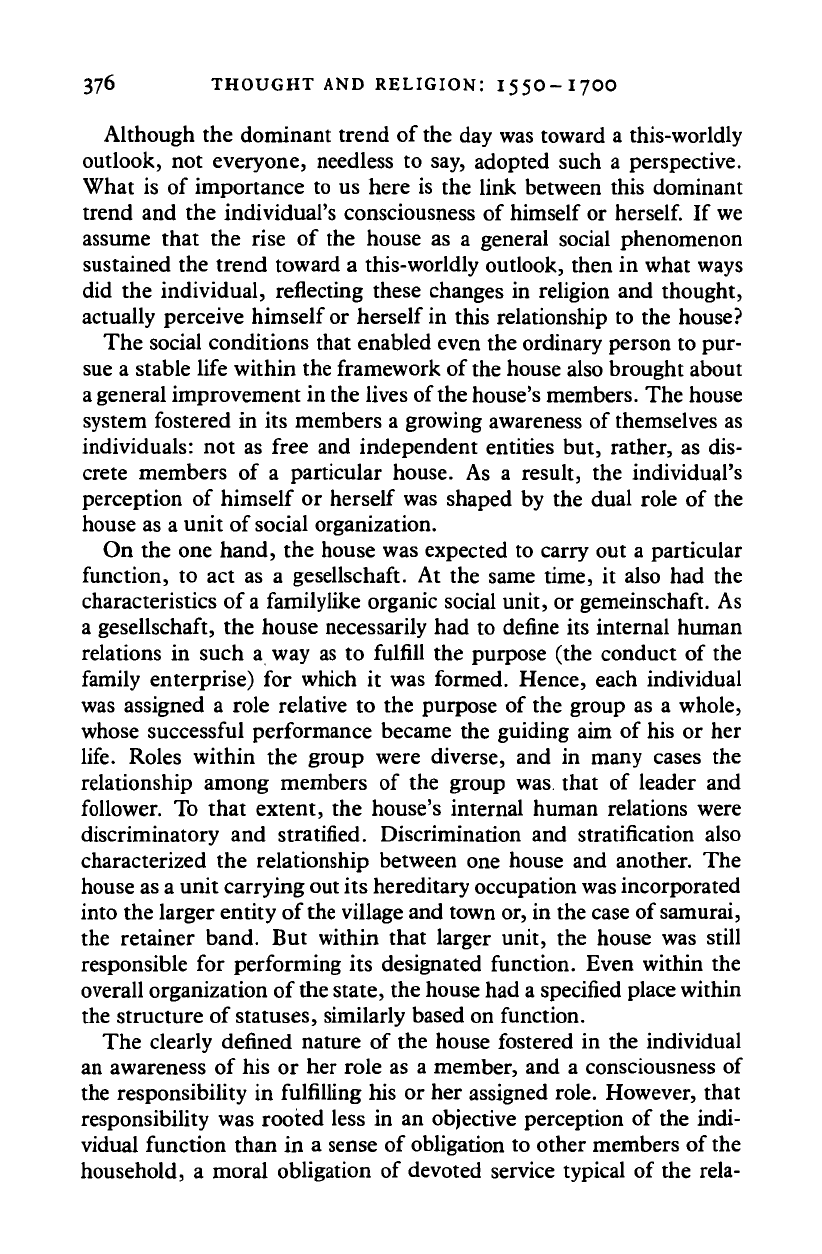
376 THOUGHT AND RELIGION: I55O-I7OO
Although the dominant trend of the day was toward a this-worldly
outlook, not everyone, needless to say, adopted such a perspective.
What is of importance to us here is the link between this dominant
trend and the individual's consciousness of himself or
herself.
If we
assume that the rise of the house as a general social phenomenon
sustained the trend toward a this-worldly outlook, then in what ways
did the individual, reflecting these changes in religion and thought,
actually perceive himself or herself in this relationship to the house?
The social conditions that enabled even the ordinary person to pur-
sue a stable life within the framework of the house also brought about
a general improvement in the lives of the house's members. The house
system fostered in its members a growing awareness of themselves as
individuals: not as free and independent entities but, rather, as dis-
crete members of a particular house. As a result, the individual's
perception of himself or herself was shaped by the dual role of the
house as a unit of social organization.
On the one hand, the house was expected to carry out a particular
function, to act as a gesellschaft. At the same time, it also had the
characteristics of
a
familylike organic social unit, or gemeinschaft. As
a gesellschaft, the house necessarily had to define its internal human
relations in such a way as to fulfill the purpose (the conduct of the
family enterprise) for which it was formed. Hence, each individual
was assigned a role relative to the purpose of the group as a whole,
whose successful performance became the guiding aim of his or her
life.
Roles within the group were diverse, and in many cases the
relationship among members of the group was that of leader and
follower. To that extent, the house's internal human relations were
discriminatory and stratified. Discrimination and stratification also
characterized the relationship between one house and another. The
house as a unit carrying out its hereditary occupation was incorporated
into the larger entity of
the
village and town or, in the case of samurai,
the retainer band. But within that larger unit, the house was still
responsible for performing its designated function. Even within the
overall organization of the state, the house had a specified place within
the structure of statuses, similarly based on function.
The clearly defined nature of the house fostered in the individual
an awareness of his or her role as a member, and a consciousness of
the responsibility in fulfilling his or her assigned role. However, that
responsibility was rooted less in an objective perception of the indi-
vidual function than in a sense of obligation to other members of the
household, a moral obligation of devoted service typical of the rela-
Cambridge Histories Online © Cambridge University Press, 2008
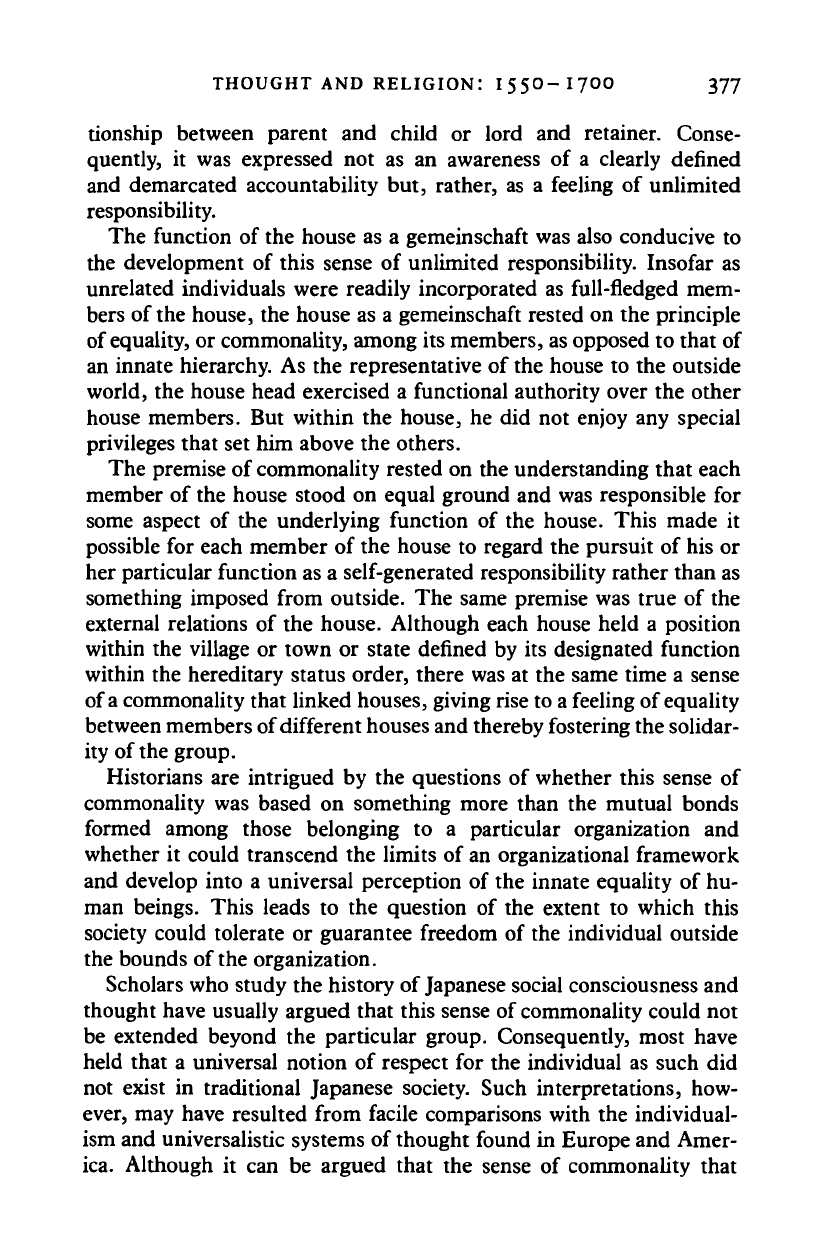
THOUGHT AND RELIGION: I55O-I7OO 377
tionship between parent and child or lord and retainer. Conse-
quently, it was expressed not as an awareness of a clearly defined
and demarcated accountability but, rather, as a feeling of unlimited
responsibility.
The function of the house as a gemeinschaft was also conducive to
the development of this sense of unlimited responsibility. Insofar as
unrelated individuals were readily incorporated as full-fledged mem-
bers of the house, the house as a gemeinschaft rested on the principle
of equality, or commonality, among its members, as opposed to that of
an innate hierarchy. As the representative of the house to the outside
world, the house head exercised a functional authority over the other
house members. But within the house, he did not enjoy any special
privileges that set him above the others.
The premise of commonality rested on the understanding that each
member of the house stood on equal ground and was responsible for
some aspect of the underlying function of the house. This made it
possible for each member of the house to regard the pursuit of his or
her particular function as a self-generated responsibility rather than as
something imposed from outside. The same premise was true of the
external relations of the house. Although each house held a position
within the village or town or state defined by its designated function
within the hereditary status order, there was at the same time a sense
of a commonality that linked houses, giving rise to a feeling of equality
between members of different houses and thereby fostering the solidar-
ity of
the
group.
Historians are intrigued by the questions of whether this sense of
commonality was based on something more than the mutual bonds
formed among those belonging to a particular organization and
whether it could transcend the limits of an organizational framework
and develop into a universal perception of the innate equality of hu-
man beings. This leads to the question of the extent to which this
society could tolerate or guarantee freedom of the individual outside
the bounds of the organization.
Scholars who study the history of Japanese social consciousness and
thought have usually argued that this sense of commonality could not
be extended beyond the particular group. Consequently, most have
held that a universal notion of respect for the individual as such did
not exist in traditional Japanese society. Such interpretations, how-
ever, may have resulted from facile comparisons with the individual-
ism and universalistic systems of thought found in Europe and Amer-
ica. Although it can be argued that the sense of commonality that
Cambridge Histories Online © Cambridge University Press, 2008

378 THOUGHT AND RELIGION: I55O-17OO
bound individuals in Japan was based on their mutual affiliation with a
particular group, the scale of that group could be expanded from the
house to the village, town, or retainer band and beyond that to the
entire nation.
Given the gemeinschaft-like nature of the house, in which no funda-
mental distinction was made between those who were linked consan-
guineously to the house and those who were not, the sense of common-
ality in fact could transcend the state or ethnic group. Similarly,
viewed from one angle, the consciousness of social responsibility as
something that, rooted in direct affective ties, could not be sharply
demarcated carried certain dangers. It might result in overly heavy
demands on the individual and thus lead to the impairment of his or
her sense of selfhood. However, considered from another angle, the
very fact that the scope of responsibility was not rigidly defined meant
that it was left up to the individual to decide how to accomplish his or
her task. Thus it was also possible for the feeling of limitless responsi-
bility to foster a sense of autonomous judgment. Whether or not that
potential was realized within the actual historical context of early mod-
ern Japan is another question. Our aim is to try to answer this ques-
tion, by examining Tokugawa society and thought.
RELIGION
The social upheaval during the fourteenth through the sixteenth cen-
turies had a profound effect on Japanese religion, for it was during
this period that what may be called a national religion was estab-
lished in Japan. The religious beliefs and institutions regarded as
characteristically Japanese reached maturity during this period and
have continued to exist, with relatively little modification, until re-
cent times. If one were to seek the origin of these religious beliefs,
one undoubtedly could trace them back'to antiquity. But it was only
during the period under consideration that religion came to penetrate
the lives of the general populace, not just as a primitive faith, but
also as a system of beliefs that had undergone considerable intellec-
tual refinement while sustained by the teachings and rituals of Bud-
dhism and Shinto. The same period saw the establishment of a com-
mon religious institution throughout the country. And it is the spread
of a common pattern of religious practice both geographically and
socially that can be cited as evidence of the establishment of a na-
tional religion. We shall next look more closely at the specific fea-
tures of this religion.
Cambridge Histories Online © Cambridge University Press, 2008
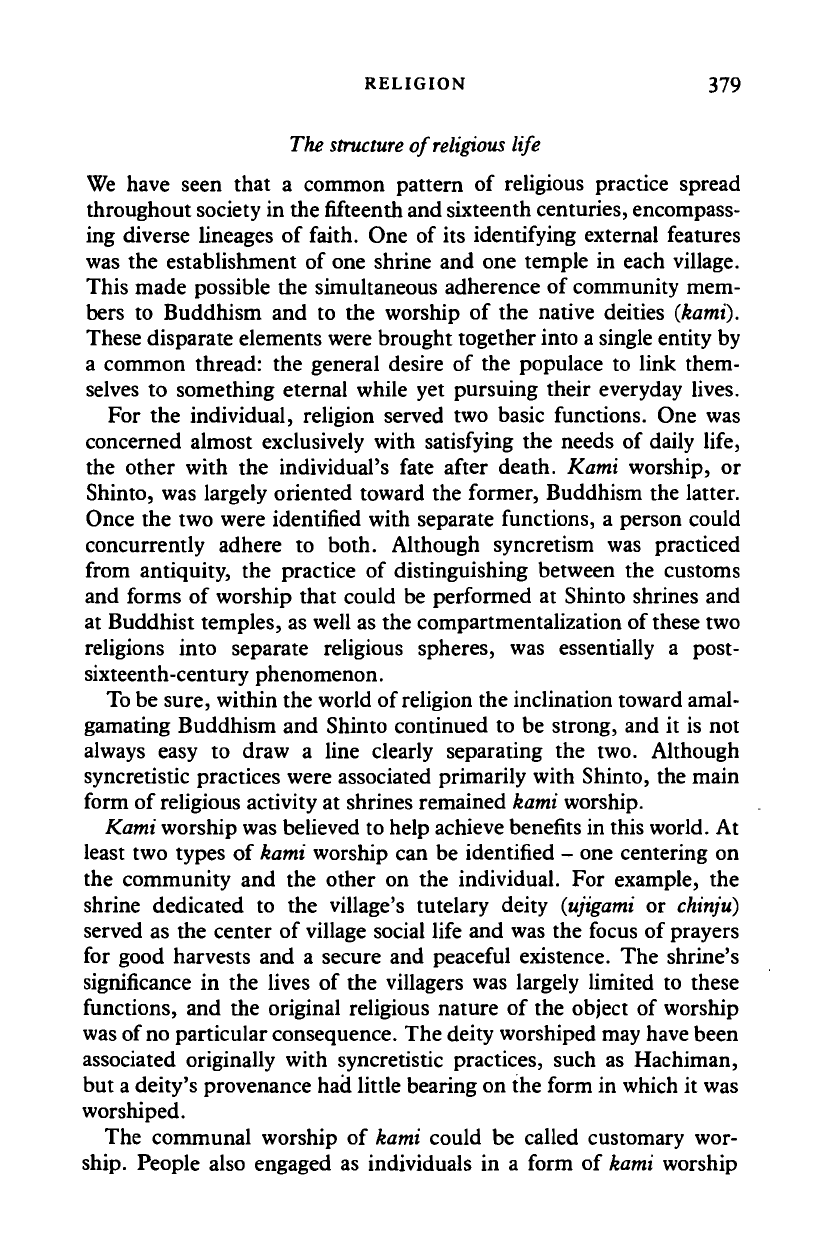
RELIGION 379
The structure of religious life
We have seen that a common pattern of religious practice spread
throughout society in the
fifteenth
and sixteenth centuries, encompass-
ing diverse lineages of faith. One of its identifying external features
was the establishment of one shrine and one temple in each village.
This made possible the simultaneous adherence of community mem-
bers to Buddhism and to the worship of the native deities (kami).
These disparate elements were brought together into a single entity by
a common thread: the general desire of the populace to link them-
selves to something eternal while yet pursuing their everyday lives.
For the individual, religion served two basic functions. One was
concerned almost exclusively with satisfying the needs of daily life,
the other with the individual's fate after death. Kami worship, or
Shinto, was largely oriented toward the former, Buddhism the latter.
Once the two were identified with separate functions, a person could
concurrently adhere to both. Although syncretism was practiced
from antiquity, the practice of distinguishing between the customs
and forms of worship that could be performed at Shinto shrines and
at Buddhist temples, as well as the compartmentalization of these two
religions into separate religious spheres, was essentially a post-
sixteenth-century phenomenon.
To be sure, within the world of religion the inclination toward amal-
gamating Buddhism and Shinto continued to be strong, and it is not
always easy to draw a line clearly separating the two. Although
syncretistic practices were associated primarily with Shinto, the main
form of religious activity at shrines remained kami worship.
Kami worship was believed to help achieve benefits in this world. At
least two types of kami worship can be identified - one centering on
the community and the other on the individual. For example, the
shrine dedicated to the village's tutelary deity (ujigami or chinju)
served as the center of village social life and was the focus of prayers
for good harvests and a secure and peaceful existence. The shrine's
significance in the lives of the villagers was largely limited to these
functions, and the original religious nature of the object of worship
was of
no
particular consequence. The deity worshiped may have been
associated originally with syncretistic practices, such as Hachiman,
but a deity's provenance had little bearing on the form in which it was
worshiped.
The communal worship of kami could be called customary wor-
ship.
People also engaged as individuals in a form of kami worship
Cambridge Histories Online © Cambridge University Press, 2008
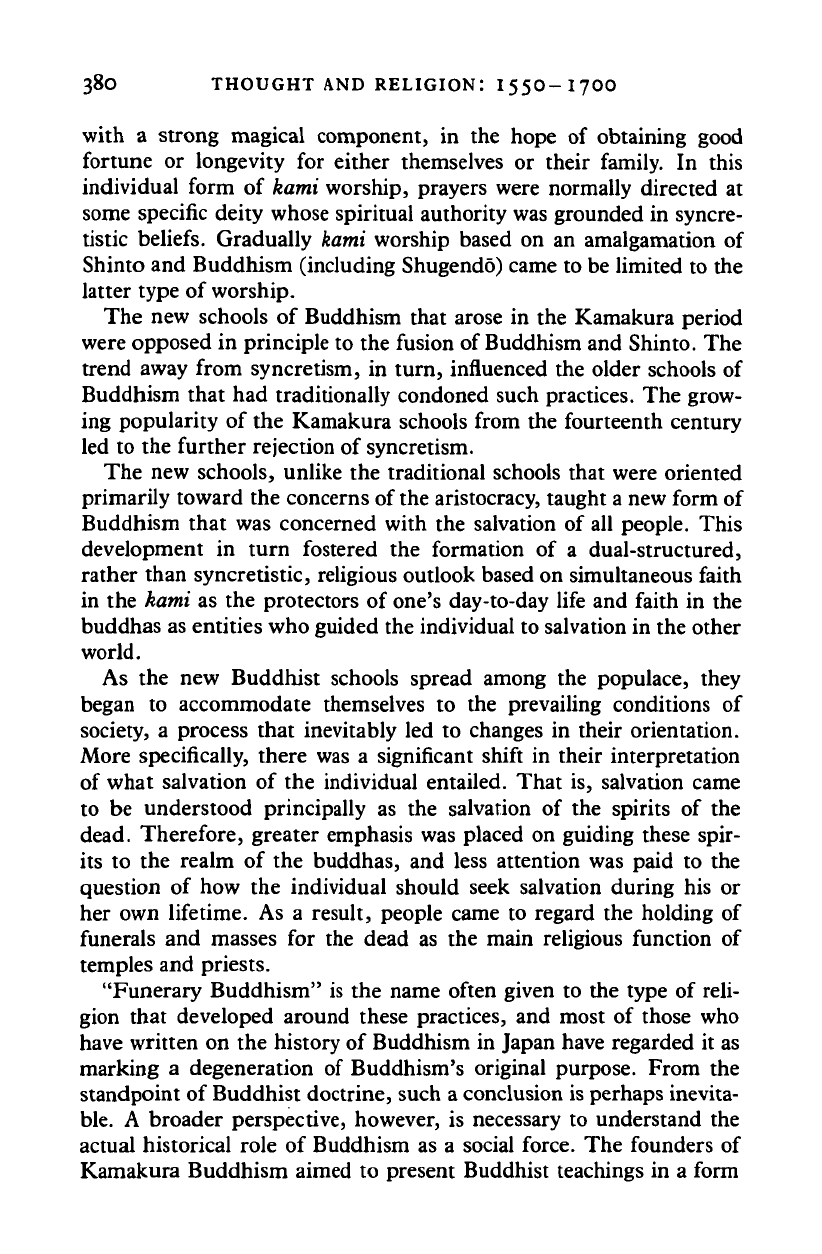
380 THOUGHT AND RELIGION: I55O-I7OO
with a strong magical component, in the hope of obtaining good
fortune or longevity for either themselves or their family. In this
individual form of kami worship, prayers were normally directed at
some specific deity whose spiritual authority was grounded in syncre-
tistic beliefs. Gradually kami worship based on an amalgamation of
Shinto and Buddhism (including Shugendo) came to be limited to the
latter type of worship.
The new schools of Buddhism that arose in the Kamakura period
were opposed in principle to the fusion of Buddhism and Shinto. The
trend away from syncretism, in turn, influenced the older schools of
Buddhism that had traditionally condoned such practices. The grow-
ing popularity of the Kamakura schools from the fourteenth century
led to the further rejection of syncretism.
The new schools, unlike the traditional schools that were oriented
primarily toward the concerns of the aristocracy, taught a new form of
Buddhism that was concerned with the salvation of all people. This
development in turn fostered the formation of a dual-structured,
rather than syncretistic, religious outlook based on simultaneous faith
in the kami as the protectors of one's day-to-day life and faith in the
buddhas as entities who guided the individual to salvation in the other
world.
As the new Buddhist schools spread among the populace, they
began to accommodate themselves to the prevailing conditions of
society, a process that inevitably led to changes in their orientation.
More specifically, there was a significant shift in their interpretation
of what salvation of the individual entailed. That is, salvation came
to be understood principally as the salvation of the spirits of the
dead. Therefore, greater emphasis was placed on guiding these spir-
its to the realm of the buddhas, and less attention was paid to the
question of how the individual should seek salvation during his or
her own lifetime. As a result, people came to regard the holding of
funerals and masses for the dead as the main religious function of
temples and priests.
"Funerary Buddhism" is the name often given to the type of reli-
gion that developed around these practices, and most of those who
have written on the history of Buddhism in Japan have regarded it as
marking a degeneration of Buddhism's original purpose. From the
standpoint of Buddhist doctrine, such a conclusion is perhaps inevita-
ble.
A broader perspective, however, is necessary to understand the
actual historical role of Buddhism as a social force. The founders of
Kamakura Buddhism aimed to present Buddhist teachings in a form
Cambridge Histories Online © Cambridge University Press, 2008
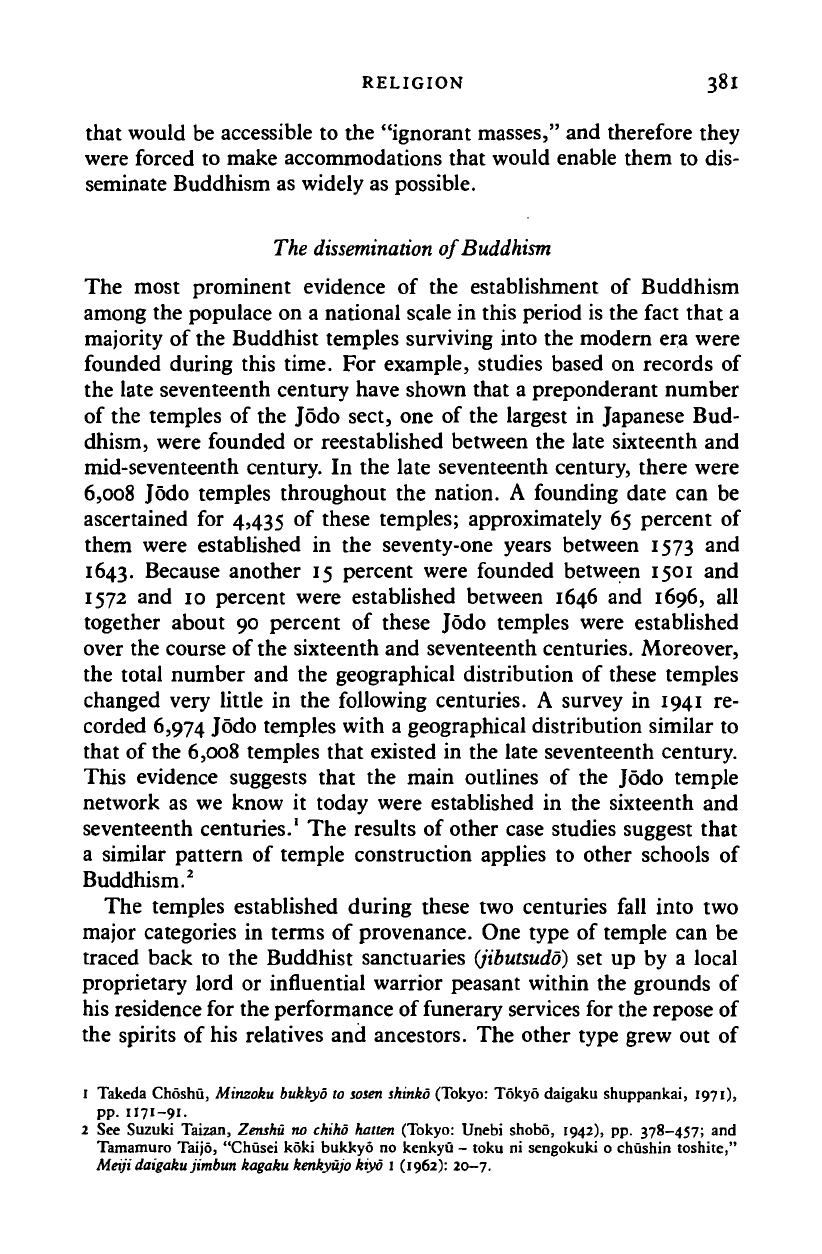
RELIGION 38I
that would be accessible to the "ignorant masses," and therefore they
were forced to make accommodations that would enable them to dis-
seminate Buddhism as widely as possible.
The dissemination of Buddhism
The most prominent evidence of the establishment of Buddhism
among the populace on a national scale in this period is the fact that a
majority of the Buddhist temples surviving into the modern era were
founded during this time. For example, studies based on records of
the late seventeenth century have shown that a preponderant number
of the temples of the Jodo sect, one of the largest in Japanese Bud-
dhism, were founded or reestablished between the late sixteenth and
mid-seventeenth century. In the late seventeenth century, there were
6,008 Jodo temples throughout the nation. A founding date can be
ascertained for 4,435 of these temples; approximately 65 percent of
them were established in the seventy-one years between 1573 and
1643.
Because another 15 percent were founded between 1501 and
1572 and 10 percent were established between 1646 and 1696, all
together about 90 percent of these Jodo temples were established
over the course of the sixteenth and seventeenth centuries. Moreover,
the total number and the geographical distribution of these temples
changed very little in the following centuries. A survey in 1941 re-
corded 6,974 J°do temples with a geographical distribution similar to
that of the 6,008 temples that existed in the late seventeenth century.
This evidence suggests that the main outlines of the Jodo temple
network as we know it today were established in the sixteenth and
seventeenth centuries.
1
The results of other case studies suggest that
a similar pattern of temple construction applies to other schools of
Buddhism.
2
The temples established during these two centuries fall into two
major categories in terms of provenance. One type of temple can be
traced back to the Buddhist sanctuaries
(jibutsudo)
set up by a local
proprietary lord or influential warrior peasant within the grounds of
his residence for the performance of funerary services for the repose of
the spirits of his relatives and ancestors. The other type grew out of
1 Takeda Choshu, Minzoku bukkyo to sosen shinko (Tokyo: Tokyo daigaku shuppankai, 1971),
pp.
1171-91.
2 See Suzuki Taizan, Zenshu no chiho haiien (Tokyo: Unebi shobo, 1942), pp. 378-457; and
Tamamuro Taijo, "Chusei koki bukkyo no kenkyu - toku ni sengokuki o chushin toshite,"
Meiji daigaku jimbun kagaku kenkyujo kiyo I (1962): 20—7.
Cambridge Histories Online © Cambridge University Press, 2008
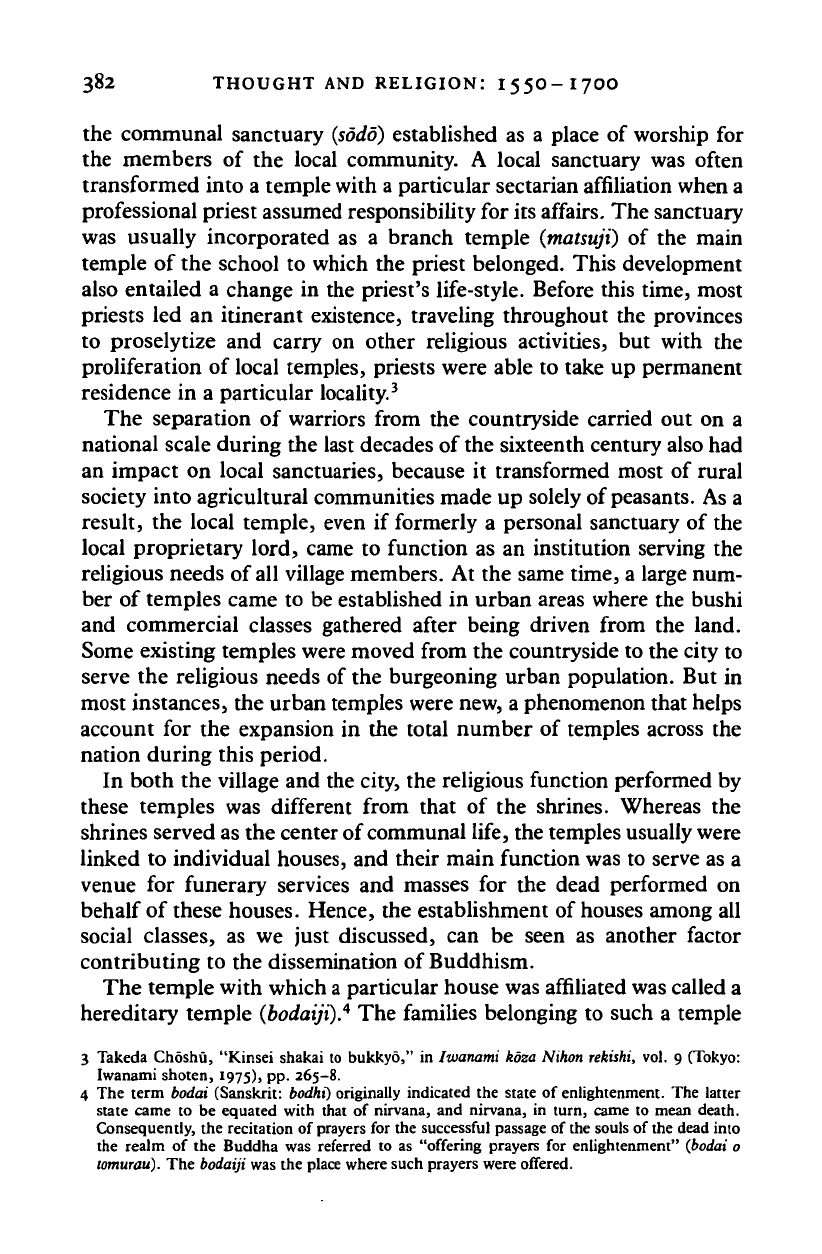
382 THOUGHT AND RELIGION: 155O-I7OO
the communal sanctuary
(sodo)
established as a place of worship for
the members of the local community. A local sanctuary was often
transformed into a temple with a particular sectarian affiliation when a
professional priest assumed responsibility for its affairs. The sanctuary
was usually incorporated as a branch temple
{matsuji)
of the main
temple of the school to which the priest belonged. This development
also entailed a change in the priest's life-style. Before this time, most
priests led an itinerant existence, traveling throughout the provinces
to proselytize and carry on other religious activities, but with the
proliferation of local temples, priests were able to take up permanent
residence in a particular locality.
3
The separation of warriors from the countryside carried out on a
national scale during the last decades of the sixteenth century also had
an impact on local sanctuaries, because it transformed most of rural
society into agricultural communities made up solely of
peasants.
As a
result, the local temple, even if formerly a personal sanctuary of the
local proprietary lord, came to function as an institution serving the
religious needs of all village members. At the same time, a large num-
ber of temples came to be established in urban areas where the bushi
and commercial classes gathered after being driven from the land.
Some existing temples were moved from the countryside to the city to
serve the religious needs of the burgeoning urban population. But in
most instances, the urban temples were new, a phenomenon that helps
account for the expansion in the total number of temples across the
nation during this period.
In both the village and the city, the religious function performed by
these temples was different from that of the shrines. Whereas the
shrines served as the center of communal life, the temples usually were
linked to individual houses, and their main function was to serve as a
venue for funerary services and masses for the dead performed on
behalf of these houses. Hence, the establishment of houses among all
social classes, as we just discussed, can be seen as another factor
contributing to the dissemination of Buddhism.
The temple with which
a
particular house was affiliated was called a
hereditary temple
(bodaiji).
4
The families belonging to such a temple
3 Takeda Choshu, "Kinsei shakai to bukkyo," in Iwanami koza Nihon rekishi, vol. 9 (Tokyo:
Iwanami shoten, 1975), pp. 265-8.
4 The term bodai (Sanskrit: bodhi) originally indicated the state of enlightenment. The latter
state came to be equated with that of nirvana, and nirvana, in turn, came to mean death.
Consequently, the recitation of prayers for the successful passage of the souls of the dead into
the realm of the Buddha was referred to as "offering prayers for enlightenment" (bodai 0
lomurau).
The bodaiji was the place where such prayers were offered.
Cambridge Histories Online © Cambridge University Press, 2008
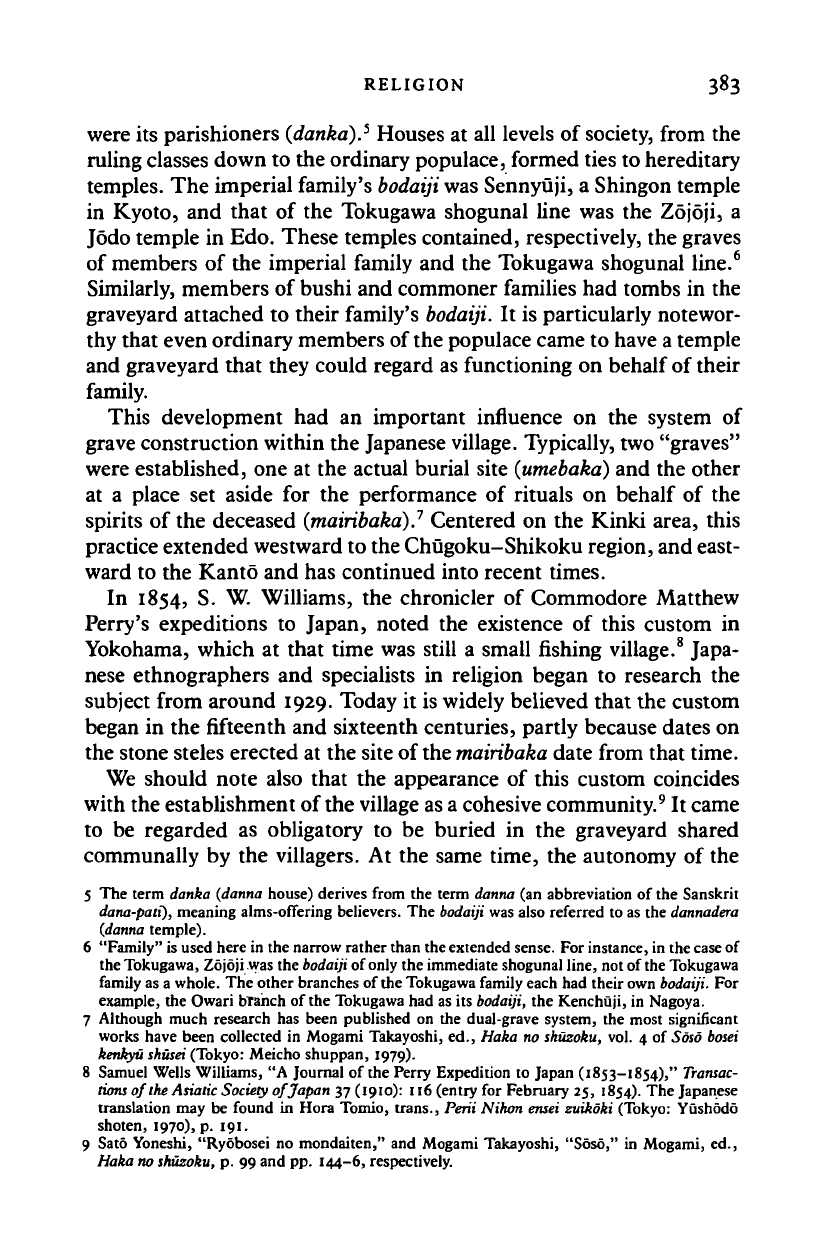
RELIGION 383
were its parishioners (danka).
s
Houses at all levels of society, from the
ruling classes down to the ordinary populace, formed ties to hereditary
temples. The imperial family's
bodaiji
was Sennyuji, a Shingon temple
in Kyoto, and that of the Tokugawa shogunal line was the Zojoji, a
Jodo temple in Edo. These temples contained, respectively, the graves
of members of the imperial family and the Tokugawa shogunal line.
6
Similarly, members of bushi and commoner families had tombs in the
graveyard attached to their family's
bodaiji.
It is particularly notewor-
thy that even ordinary members of the populace came to have
a
temple
and graveyard that they could regard as functioning on behalf of their
family.
This development had an important influence on the system of
grave construction within the Japanese village. Typically, two "graves"
were established, one at the actual burial site
(umebaka)
and the other
at a place set aside for the performance of rituals on behalf of the
spirits of the deceased
(tnairibaka).
7
Centered on the Kinki area, this
practice extended westward to the Chugoku-Shikoku region, and east-
ward to the Kanto and has continued into recent times.
In 1854, S. W. Williams, the chronicler of Commodore Matthew
Perry's expeditions to Japan, noted the existence of this custom in
Yokohama, which at that time was still a small fishing village.
8
Japa-
nese ethnographers and specialists in religion began to research the
subject from around 1929. Today it is widely believed that the custom
began in the fifteenth and sixteenth centuries, partly because dates on
the stone steles erected at the site of the
mairibaka
date from that time.
We should note also that the appearance of this custom coincides
with the establishment of the village as
a
cohesive community.
9
It came
to be regarded as obligatory to be buried in the graveyard shared
communally by the villagers. At the same time, the autonomy of the
5 The term danka (danna house) derives from the term danna (an abbreviation of the Sanskrit
dana-pati),
meaning alms-offering believers. The bodaiji was also referred to as the dannadera
{danna temple).
6 "Family" is used here in the narrow rather than the extended sense. For instance, in the case of
the Tokugawa, Zojoji was the bodaiji of only the immediate shogunal line, not of the Tokugawa
family as a whole. The other branches of the Tokugawa family each had their own bodaiji. For
example, the Owari branch of the Tokugawa had as its bodaiji, the Kenchuji, in Nagoya.
7 Although much research has been published on the dual-grave system, the most significant
works have been collected in Mogami Takayoshi, ed., Haka no shuzoku, vol. 4 of Soso bosei
kenkyu shusei
(Tokyo: Meicho shuppan, 1979).
8 Samuel Wells Williams, "A Journal of the Perry Expedition to Japan (1853-1854),"
Transac-
tions
of
the
Asiatic Society of Japan yj (1910): 116 (entry for February 25, 1854). The Japanese
translation may be found in Hora Tomio, trans., Perii Nihon ensei zuikdki (Tokyo: Yushodo
shoten, 1970), p. 191.
9 Sato Yoneshi, "Ryobosei no mondaiten," and Mogami Takayoshi, "Soso," in Mogami, ed.,
Haka no shuzoku, p. 99 and pp. 144-6, respectively.
Cambridge Histories Online © Cambridge University Press, 2008
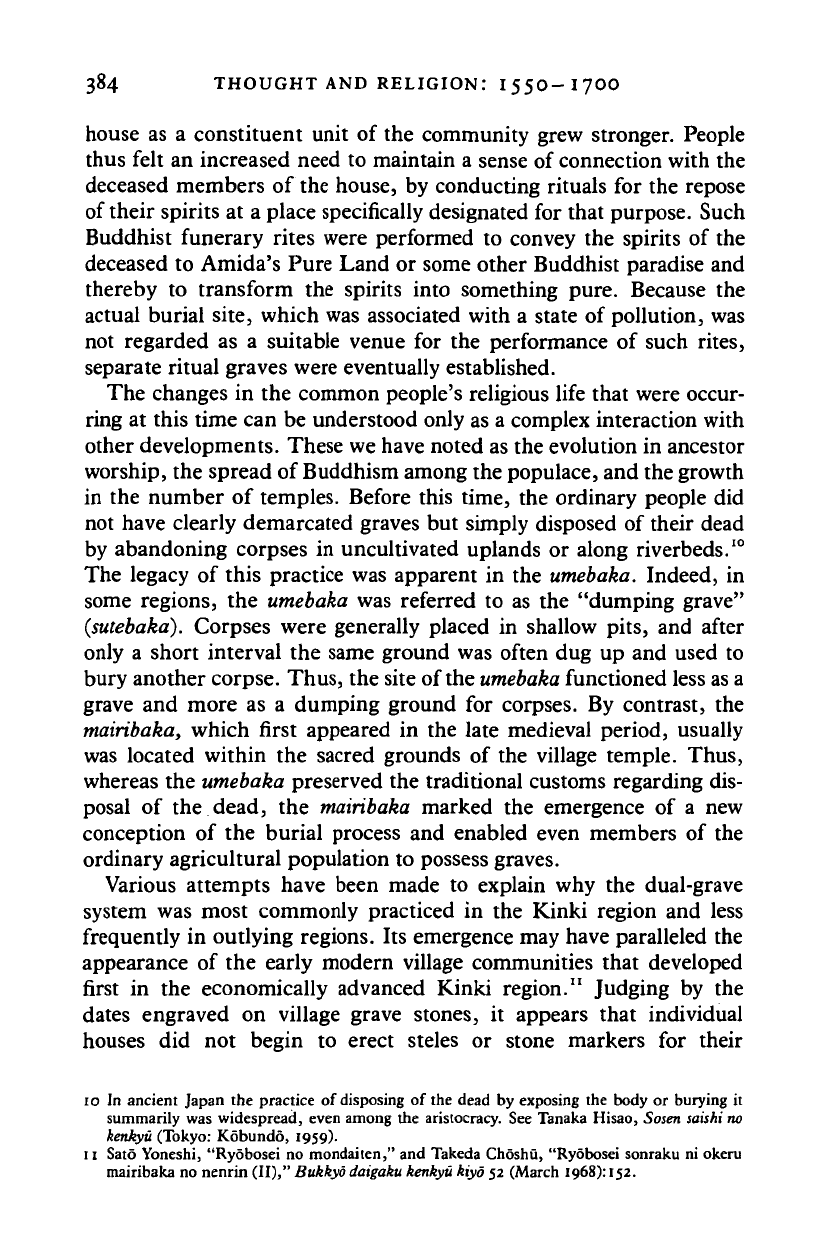
384 THOUGHT AND RELIGION: I55O-I7OO
house as a constituent unit of the community grew stronger. People
thus felt an increased need to maintain a sense of connection with the
deceased members of the house, by conducting rituals for the repose
of their spirits at a place specifically designated for that purpose. Such
Buddhist funerary rites were performed to convey the spirits of the
deceased to Amida's Pure Land or some other Buddhist paradise and
thereby to transform the spirits into something pure. Because the
actual burial site, which was associated with a state of pollution, was
not regarded as a suitable venue for the performance of such rites,
separate ritual graves were eventually established.
The changes in the common people's religious life that were occur-
ring at this time can be understood only as a complex interaction with
other developments. These we have noted as the evolution in ancestor
worship, the spread of Buddhism among the populace, and the growth
in the number of temples. Before this time, the ordinary people did
not have clearly demarcated graves but simply disposed of their dead
by abandoning corpses in uncultivated uplands or along riverbeds.
10
The legacy of this practice was apparent in the
umebaka.
Indeed, in
some regions, the
umebaka
was referred to as the "dumping grave"
(sutebaka).
Corpses were generally placed in shallow pits, and after
only a short interval the same ground was often dug up and used to
bury another corpse. Thus, the site of the
umebaka
functioned less as a
grave and more as a dumping ground for corpses. By contrast, the
mairibaka, which first appeared in the late medieval period, usually
was located within the sacred grounds of the village temple. Thus,
whereas the
umebaka
preserved the traditional customs regarding dis-
posal of the dead, the mairibaka marked the emergence of a new
conception of the burial process and enabled even members of the
ordinary agricultural population to possess graves.
Various attempts have been made to explain why the dual-grave
system was most commonly practiced in the Kinki region and less
frequently in outlying regions. Its emergence may have paralleled the
appearance of the early modern village communities that developed
first in the economically advanced Kinki region.
11
Judging by the
dates engraved on village grave stones, it appears that individual
houses did not begin to erect steles or stone markers for their
10 In ancient Japan the practice of disposing of the dead by exposing the body or burying it
summarily was widespread, even among the aristocracy. See Tanaka Hisao, Sosen saishi no
kenkyu (Tokyo: Kobundo, 1959).
11 Sato Yoneshi, "Ryobosei no mondaiten," and Takeda Choshu, "Ryobosei sonraku ni okeru
mairibaka no nenrin (II)," Bukhyb daigaku kenkyu kiyo 52 (March
1968):
152.
Cambridge Histories Online © Cambridge University Press, 2008
